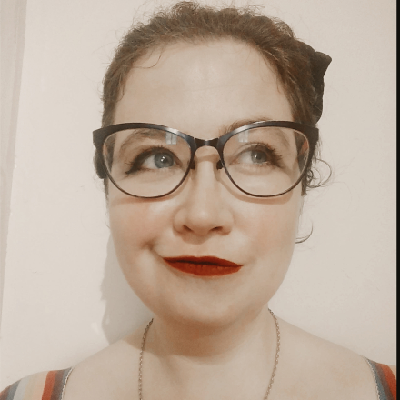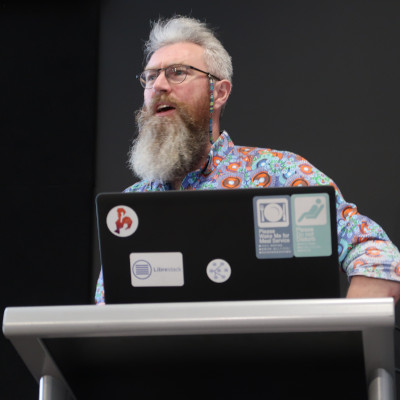Esther Payne and Brett Sheffield - Librecast
E2E encrypted multicast

Can you introduce yourself and your project?

The Librecast Project is a Human Rights project masquerading as a technology project. We develop Free and Open Source software based on multicast to protect and enhance Human Rights. Human Rights cannot exist without the ability for humans to communicate. Without the ability to share and discuss information freely, consensually, and at scale, there can be no effective democracy. Without democracy, all of our rights are at risk.

In an increasingly globalized society, the internet has become the essential foundation on which our democracies and human rights depend. Our society is global. Whether a genocide occurs in Europe, the Middle East, or Africa, we need to know. We need to know when the Amazon rainforest is being logged or if island communities in the Pacific are drowning due to global warming. We need to know when the social media company we use to share pictures of our children with family and friends is engaged in election interference in the UK or South America.
Our rights depend on it.
Librecast builds human systems on a multicast base. Multicast is simply a fancy technological word meaning “group communication”. It is “networking with consent”. Brett always wanted to connect geographically separate communities online, starting when he co-founded JOTI (Scouts Jamboree on the Internet) as a Queen’s Scout in Australia in the 1990s.
Esther found that after she completed her Computer Science Honours degree at Robert Gordon University, she preferred people to programming. She has worked on several projects that aim to create the Next Generation Internet, focusing on privacy and human rights.
Both consider multicasting an efficient way to orchestrate our infrastructure and connect our communities.
What are the key issues you see with the state of the internet today?
Many of the internet protocols that we depend upon today were designed at a time when privacy and security were not priorities. The requirements of an academic network differ significantly from the network we need to use daily for our banking, shopping, and social lives with family and friends, as well as for learning about the world around us, informing ourselves politically, and organizing. The internet was designed for something other than this.
Democracy requires freedom of speech and association. Global events impact our society, and so global communication is required. This communication tool needs to be impervious to internet blocking and censorship employed frequently by authoritarian governments worldwide. It needs to be resistant to surveillance by trillion-dollar corporations such as Facebook, Google, and Amazon, who have shown time and again that they will monetize and exploit our data without our consent, even engaging in overt acts to subvert democracy at home and abroad. The increasingly centralized nature of our unicast internet makes us more vulnerable to surveillance and censorship and risks our privacy.
How does your project contribute to correcting some of those issues?
The Librecast Project is building the software required to rebuild our internet using multicast, with privacy, accessibility, and efficiency as design goals from the outset. Multicast delivers networking with consent. You only receive the data you subscribe to and can unsubscribe anytime. This approach has accessibility benefits. Each platform user will be in control by allowing the end user to choose which channels to subscribe to and leaving rendering until as late as possible.
As a sighted user, you may choose to subscribe to visual media. As a hearing user, you may choose to subscribe to audio channels. The source (sender) chooses which data to share, and the subscribers choose which data to consume and decide how that data is rendered. Multicast delivers data efficiently to multiple destinations using the network layer. This reduces server load and saves bandwidth, money, and the environment. The world has over 8 billion people and all their devices. Most of these personal and IoT devices require regular software updates to be secure and protect our privacy. Delivering these updates over multicast saves money and the planet.
What do you like most about (working on) your project?
Working on Librecast allows us to do something positive while working on exciting and challenging technical problems. We don't do this alone. We have no competitors. Everyone who is working to improve and protect Human Rights is our ally. There are many paths to the top of this mountain.
Working and connecting with other projects in the NGI Space always brings interesting new ideas for technology and how our communities should form and communicate. It’s excellent to find other people with the same goals of creating a more human-centric internet. From packages for various distributions to fellow NGI projects, it’s lovely to find people with similar goals. It's great for collaboration, and it inspires development. Publishing our code and getting interest and feedback from the community encourages us to continue.
Where will you take your project next?
Now that much of the base platform and libraries are in place, we plan to shift the focus to working on the front end of Librecast Studio. We will continue to develop and improve the base Librecast libraries and encourage their adoption by other developers and projects. We are always looking for new projects with which to collaborate.
How did NGI Assure help you reach your goals for your project?
NGI Assure and NLnet provided both funding and encouragement to help us achieve:
- Improvements to base IPv6 multicast library.
- Work on transitional tunnelling, enabling decentralized peer-to-peer overlay multicast.
- Improvements to our LCRQ Forward Error Correction and Network Coding library.
- The publication of a new multicast file syncing tool: lcsync.
Do you have advice for people who are considering to apply for NGI funding?
- Be clear on what you want to do: Spend some time thinking about what you want to build and the specifics of that. You want to make it easier for the reviewers to say yes.
- Research the fund and what its aims are for: Research the partnerships that contribute to those funds. Several organizations, including FundingBox and the NLnet Foundation, have years of experience managing funds and supporting grantees. Research the partners to find what their specialities are and which projects they have funded in the past. Plan for more than just the money in the grant. Consider taking advantage of the services offered by those in the fund partnership.
- Look at similar projects funded by similar funds or that fund if it’s in the middle of several rounds. Talk to the organizers of the funding body. They want to give you funding and help you gain that funding.
- Consider what you want to do in the future beyond the initial application: Remember that this is public funding, so if you get that funding, your obligation will go beyond the grant. There is an obligation to the citizens of the EU and the FOSS community. We want to ensure long-term investment from the EU, so we need to show we want that sustainability and look for more ways to ensure that.
Do you have any recommendations to improve future NGI programs or the wider NGI initiative?
- Expand where you look for innovators, and look beyond Twitter and Facebook. Particularly if you care about diversity. Look at the Fediverse and Bluesky. Keep up the partnership with NLnet. NGI Assure was a unique combination of funds; it has an untapped community of talent that Horizon EU and other research and innovation funds could discover. Librecast has benefited enormously from the community fostered by NGI Assure and also the greater FOSS community.
- Consider funding work to bridge the existing NGI community space to Matrix. While they are based in the UK, the protocol has many of the existing innovators communicating on Matrix Channels. While the community space has many innovators, Matrix has the advantage of several clients, not just a website space. This would also enable the partners of the various NGI funds to connect with the community to create new opportunities.
- Find ways to collaborate with organizations like the Linux Foundation and CHAOSS to help Innovators connect and be able to present in person. Be sure to let the community know that you have.
- Consider creating funds to help developers focus on the code. Fund the people in their communities who support them in grant writing, community management, testing, and packaging. FOSS is an ecosystem, but when the focus is on funding code milestones, many parts aren't directly funded, which can add a burden on developers who are already underfunded. NGI recently published an article on the lack of diversity in Tech. This is partly because of the lack of funding available to the general pool of expertise in the EU. Suppose you want to continue to build the Next Generation Internet for every resident of the EU and beyond. In that case, it needs to fund people outside the social structures within the tech sector to help create a diverse ecosystem.
- We also need to look outside the norms of contributions being coded. We need to invest in people rather than technology. Ideally, the systems we build within Tech are meant to solve problems in the physical world. The systems we build have real-world consequences, so that we design for the issues and reduce harm, we need a broader range of skill sets. We need more than people who can code. While code is an easy metric to measure immediate success, you need more people to be able to take advantage of the code we create.
Acknowledgements
Images: courtesy of Esther Payne and Brett Sheffield.
Published on September 5, 2024
Librecast received funding through the NGI Assure Fund, a fund established by NLnet with financial support from the European Commission's Next Generation Internet programme, under the aegis of DG Communications Networks, Content and Technology under grant agreement No 957073.




